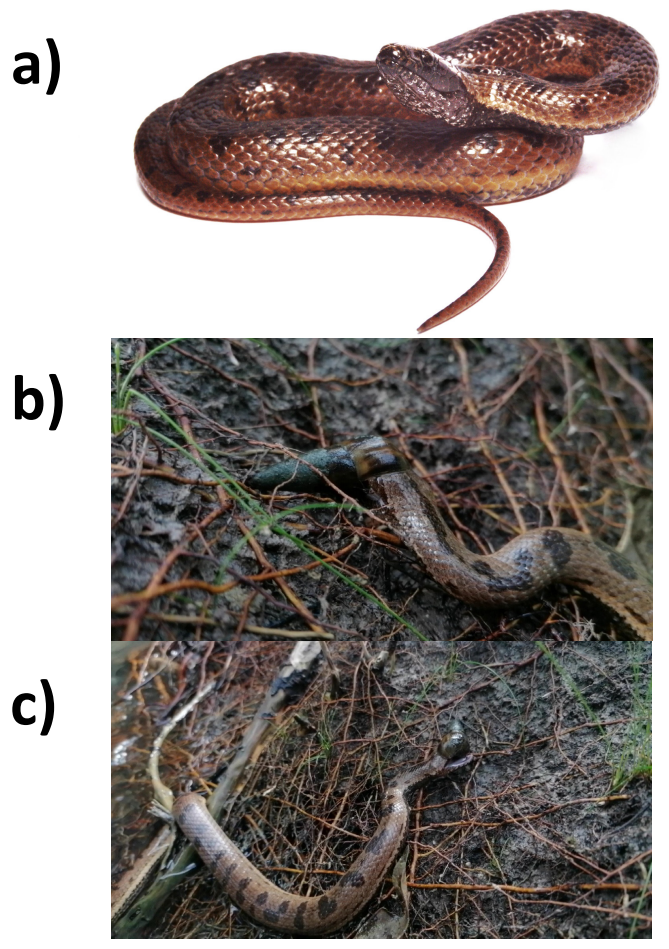The Orange-bellied swamp snake (Tretanorhinus nigroluteus) is a moderately robust water snake with dark spots or blotches on a pale grayish or dark olive dorsum; venter usually orange-red at least posteriorly; nostrils directed upward; nasal scales enlarged, in contact or narrowly separated; dorsal scales keeled and in 21 or 19 rows at midbody; anal plate divided (Heimes, 2016). This species occurs at low and moderate elevations (up to 500 m a.s.l.) on the Atlantic versant from southern Veracruz and the IIsthmus of Tehuantepec region of Oaxaca through Tabasco, northern Chiapas, western Campeche and extreme southern Quintana Roo southward to Panama (Dunn, 1939; Conant, 1965; Álvarez del Toro, 1973, 1982; Johnson, 1989; Pérez- Higareda & Smith, 1991; Lee, 1996; Vogt et al., 1997 all cited in Heimes, 2016). As many as five subspecies have been recognized (Villa, 1969), but according to Wilson and Hahn (1973) the division into subspecies is insufficiently supported.
These primarily aquatic snakes inhabit humid lowland forests and coastal mangroves, they appear to prefer shallow, slow-moving water, especially where aquatic vegetation is abundant. They have been found in or near streams, in the sluggish oxbows of large rivers, lakes and freshwater as well as brackish tree swamps. They are nocturnal and rarely seen during the day when they remain submerged or hide among aquatic vegetation. They often lie at the surface with only the snout above water and rapidly dive to hide in vegetation, mud or under rocks at the bottom (Villa, 1969; Wilson & Hahn, 1973). Tretanorhinus nigroluteus is oviparous. Females with oviductal eggs have been collected in January and July, indicating an extensive breeding season, clutches commonly number 6 to 9 eggs (Villa, 1970; Campbell, 1998). They prey on small fishes of the families Gobiidae and Poeciliidae, tadpoles and small frogs and toads (Villa, 1970; Heimes, 2016). Feeding may involve active swimming, but usually the snakes are anchored to aquatic vegetation or lie on the bottom to ambush their prey (Heimes, 2016).
On August 29, 2021 at 09:09, in the community of Tres Lagunas belonging to the mayan lacandon community of Lacanjá Chansayab in the municipality of Ocosingo, Chiapas at 353 meters above sea level (16.840908° N, 91.144765° W, UTM WGS84), AIMM and ECC observed an adult individual of T. nigroluteus (400 mm total length) feeding on a snail of the species Pachychilus largillierti known locally as "shuti de río" (Fig.1) about 3 cm. The snake was photographed during the ingestion of the snail, and it took approximately half an hour to proceed to complete ingestion of the prey. After the ingestion of the snail, the snake was captured for some photographs and the total length of the specimen was measured and subsequently released under dead branches on the river bank, no further measurements were made, nor was the specimen sexed in order to not cause more significant stress and avoid regurgitation. To our knowledge, this is the first time this species has been recorded feeding on freshwater snails.

This fortuitous discerning allows us to know more about the preference in their prey. In the river zone in which the snake T. nigroluteus was found, the presence of the snail Pachychilus largillierti is abundant, so it can be assumed that having a great availability of this resource prefers to make use of it than other organisms such as fish. This snake species is considered rare and this record also represents the third known specimen from the Selva Lacandona (Hernández-Ordoñez et al., 2015; Ferreira-García & Canseco-Márquez, 2006).
SUPPLEMENTARY INFORMATION
Three videos are provided where you can see a specimen of T. nigroluteus preying on the snail Pachychilus largillierti (https://drive.google.com/drive/folders/17FanE6PE6koEa_J8ZgUg8zjNRkRPGPr6?usp=sharing)











 nueva página del texto (beta)
nueva página del texto (beta)


